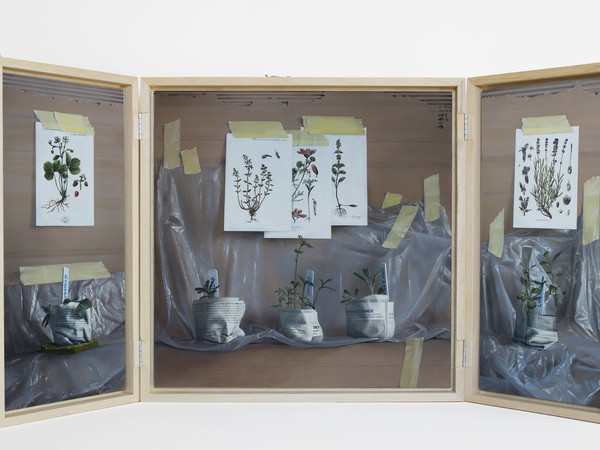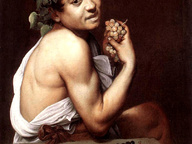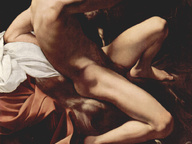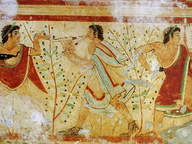Jesús Herrera Martínez. Taking Care of the Garden of Eden

Jesús Herrera Martínez, Have 02. Oil on canvas, 50x100 cm. (open), 2018
From 22 Settembre 2018 to 03 Novembre 2018
Rome
Place: White Noise Gallery
Address: via della Seggiola 9
Times: Mar-Ven 11-19; Sab 16-20
Responsibles: Eleonora Aloise, Carlo Maria Lolli Ghetti
Organizers:
- Con il patrocinio della Reale Accademia di Spagna a Roma
Ticket price: ingresso gratuito
E-Mail info: info@whitenoisegallery.it
Official site: http://https://whitenoisegallery.it/
For his second solo show at White Noise Gallery, Spanish painter Jesús Herrera Martínez presents a new cycle of works entitled “Taking Care of the Garden of Eden”. Giving his own representation of nature, Jesus reflects on the physical impossibility for the artist to give an objective and detached portrait of reality.
The show is conceived like a botanical garden: an impossible attempt to enclose in a single place the vastness of nature. Built as perfect images of the whole, those places are the synthesis of all the beauty and complexity of creation; there, species from totally different environments can finally coexist.
The viewer will not look at a garden but he will stare at the entire world.
Each work is conceived as a fragment of a secret garden, one line of the absolute picture, created to be kept and carried around.
That’s the case with the Have,foldable polyptychs to be worn as backpacks and opened to the need, as if they were moving windows on a perfect garden. So, the hexagons, meticulously covered by an oil-painted fauna, are ready to transform any surface in a tiny plot of jungle. Is up to the collector to build a composition of hexagons to create its own and unique garden of Eden.
Jesus work carries on the same spirit of the ancient Wunderkammer, where scientific rigour is often replaced by pure fascination. The seed for his research lays in the work of artists like Albert Eckhout. In his work we can see an early representation of exotic wonders from the coast of Brasil, pictured as Flemish still-lives.
Each piece of the show is both rigorous and clean as a botanical illustration and contaminated by the hand and the imagination of the artist. Jesús acts as the keeper of Eden, the absolute garden, portraing it through different mediums: from canvas to ceramic. With the accuracy of a baroque curator he creates the complete herbarium of an impossible garden.
The elaborated technique used by Jesus Herrera for this research goes far beyond the physical limitation of the painting and explores the third dimension; the oil invades the frame until it becomes a camouflage that covers and uncovers everything with the representation of the perfect garden. The supreme skill behind the paintings is always functional for their significance; the main character of the show is clearly the nature, not the technique.
In the show everything but five ceramic sculptures are covered in paint: five, pristine, Platonic solids, symbolic avatars of an absolute and distant science that doesn’t show up in Jesus’s ideal garden but rather measures it. That perfect and fair yardstick that the artist constantly pursues but never achieves.
The show is conceived like a botanical garden: an impossible attempt to enclose in a single place the vastness of nature. Built as perfect images of the whole, those places are the synthesis of all the beauty and complexity of creation; there, species from totally different environments can finally coexist.
The viewer will not look at a garden but he will stare at the entire world.
Each work is conceived as a fragment of a secret garden, one line of the absolute picture, created to be kept and carried around.
That’s the case with the Have,foldable polyptychs to be worn as backpacks and opened to the need, as if they were moving windows on a perfect garden. So, the hexagons, meticulously covered by an oil-painted fauna, are ready to transform any surface in a tiny plot of jungle. Is up to the collector to build a composition of hexagons to create its own and unique garden of Eden.
Jesus work carries on the same spirit of the ancient Wunderkammer, where scientific rigour is often replaced by pure fascination. The seed for his research lays in the work of artists like Albert Eckhout. In his work we can see an early representation of exotic wonders from the coast of Brasil, pictured as Flemish still-lives.
Each piece of the show is both rigorous and clean as a botanical illustration and contaminated by the hand and the imagination of the artist. Jesús acts as the keeper of Eden, the absolute garden, portraing it through different mediums: from canvas to ceramic. With the accuracy of a baroque curator he creates the complete herbarium of an impossible garden.
The elaborated technique used by Jesus Herrera for this research goes far beyond the physical limitation of the painting and explores the third dimension; the oil invades the frame until it becomes a camouflage that covers and uncovers everything with the representation of the perfect garden. The supreme skill behind the paintings is always functional for their significance; the main character of the show is clearly the nature, not the technique.
In the show everything but five ceramic sculptures are covered in paint: five, pristine, Platonic solids, symbolic avatars of an absolute and distant science that doesn’t show up in Jesus’s ideal garden but rather measures it. That perfect and fair yardstick that the artist constantly pursues but never achieves.
SCARICA IL COMUNICATO IN PDF
COMMENTI

-
 Dal 31 gennaio 2024 al 04 maggio 2025
Fermo | Palazzo dei Priori
Dal 31 gennaio 2024 al 04 maggio 2025
Fermo | Palazzo dei Priori
-
 Dal 20 dicembre 2024 al 04 maggio 2025
Fermo | Palazzo dei Priori
Dal 20 dicembre 2024 al 04 maggio 2025
Fermo | Palazzo dei Priori
-
 Dal 20 dicembre 2024 al 04 maggio 2024
Gorizia | Palazzo Attems Petzenstein
Dal 20 dicembre 2024 al 04 maggio 2024
Gorizia | Palazzo Attems Petzenstein
-
 Dal 18 dicembre 2024 al 18 dicembre 2024
Venezia | Museo Correr
Dal 18 dicembre 2024 al 18 dicembre 2024
Venezia | Museo Correr
-
 Dal 14 dicembre 2024 al 02 marzo 2025
Palermo | Palazzo Abatellis
Dal 14 dicembre 2024 al 02 marzo 2025
Palermo | Palazzo Abatellis
-
 Dal 12 dicembre 2024 al 23 febbraio 2025
Roma | Palazzo Altemps
Dal 12 dicembre 2024 al 23 febbraio 2025
Roma | Palazzo Altemps


